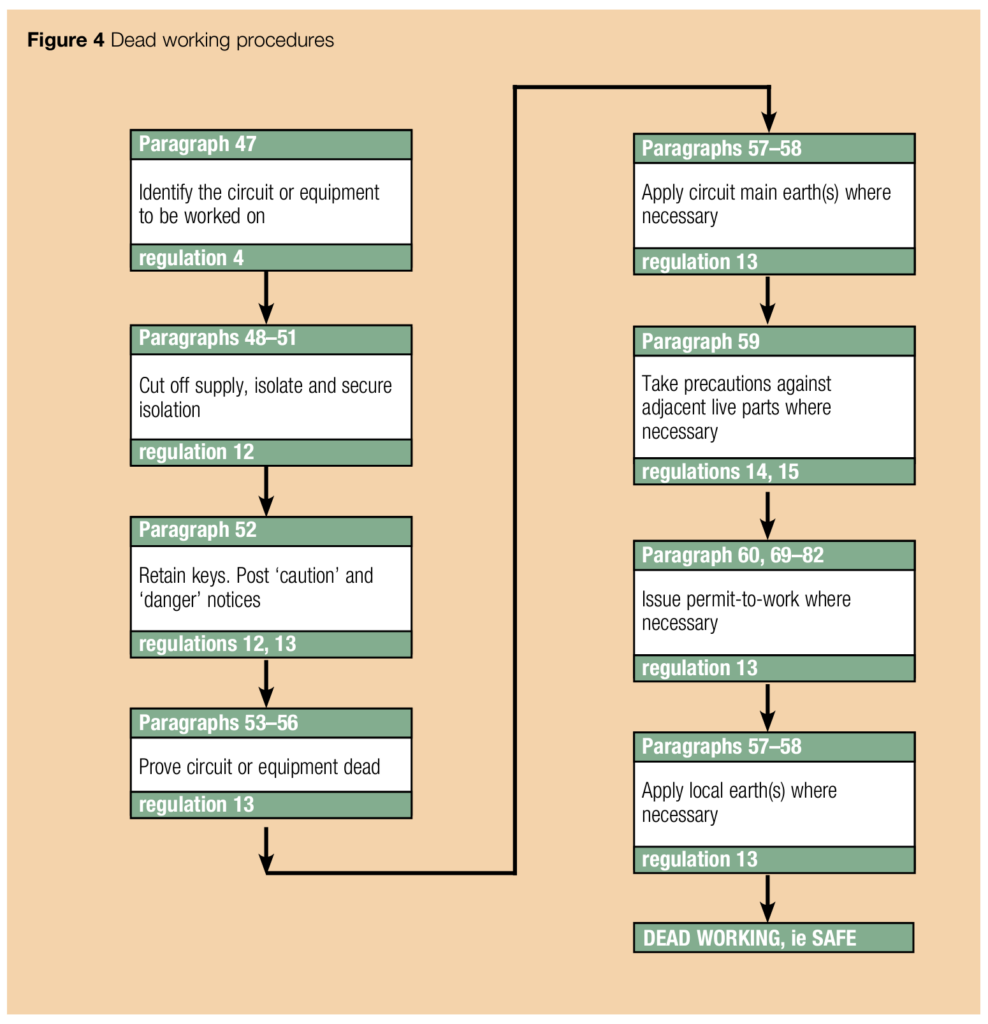
Does your Safe System of Work properly define the roles of your key personnel working on Low Voltage systems, less than or equal to 1000 V (AC) / 1500 V (DC)?
We have racked the brains of one of our HV/LV Electrical Systems Training Manager, Graham Taylor to piece together a brief guide to dead working.
A Method of Safe Working on LV Electrical Systems
The normal policy for working on any electrical system is to work dead.
By referencing and adding context to guidance documents and legislation, we hope to provide a brief overview of Low Voltage working rules.
It is acknowledged that standardisation of Safe Systems of Work would be desirable across all industries. Although industry specific recommendations may differ, the universal methodology that would be followed is often referred to as ‘The Golden Rules’ of electrical safety.
Point isolations might be carried out by the person doing the task (Competent Person (CP) / Skilled Person (SKP)). These self isolations do not require a Permit to Work (PTW) but the same methodology would be employed.
If a safety document such as a permit to work is to be issued, all of the following steps would be carried out by the Authorised Person (AP).
Planning
This might include:
- Identification of Equipment
- Consideration of RAMS
- Writing out a Safety Programme (if a safety document is issued)
- Obtaining permissions / giving notifications
- Etc.
Isolate (Locks, Keys and Signage)
The act of carrying out safe isolation, demonstrates understanding and compliance with Regulation 12 of the Electricity at Work Regulations.
Prove Dead/ Earth
To comply with Regulation 13 of the Electricity at Work Regulations, it is a necessary precaution to prove that the above isolations are correct.
Applying an earth, discharges any stored energy and places conductors at the same potential (voltage) as the person engaged in the work. Securing this ‘earth’ ensures conductors remain ‘dead’.
Issue (Documents and Keys)
The duty AP would be responsible for issuing any documentation required by the Person in Charge (PIC) of the working group. Such as a PTW.
Only the leader of the team carrying out the task can sign to accept the safety document.
Confirm Dead
This step would be required if Prove Dead cannot be carried out, however it is the same activity, just at a different time. (After this issue step).
After following these steps, dead working can now begin.

What to Expect
Delegates on all of our Authorised Person Low Voltage training courses carry out a series of practical exercises and assessments.
These are designed to help our training team assess their overall understanding of Low Voltage Electrical safe operations as part of the course assessment criteria.
Understanding Electrical Safety Law
Our explanation above primarily follows the flow chart shown, which is taken from the HSE’s guidance note, HSG85.
Any Electrical Safety Rules (ESRs) that you may have been provided with / are available, such as the NHS’ HTM 06-02 and MoD’s JSP375 Vol3 may explain these steps using tables instead of flow charts.
By correctly following the ‘Golden Rules’ above, personnel carrying out works on LV systems are more likely to be complying with the Electricity at Work Regulations 1989, Regulations 12 and 13.
For the purposes of this article, we have referred to the person following these rules, issuing documents and carrying out checks as the Authorised Person. However, you may call this person something different.
It is important, in any case, to emphasise the understanding of compliance with Regulation 16 of the Electricity at Work Regulations 1989.
Guidance on Allocation of Responsibilities:
“240. Employees must be trained and instructed to ensure that they understand the safety procedures which are relevant to their work and must work in accordance with any instructions or rules laid down by their employer and directed at ensuring safety.”
Source: HSR25 Guidance on Regulations: The Electricity at Work Regulations 1989
This guidance also states that:
“A certain amount of technical knowledge or experience is required, which should include:
- Adequate knowledge of electricity;
- Adequate experience of the electrical work;
- Adequate understanding of the system;
- Understanding of the hazards which may arise during the work…
- The ability to recognise at all times whether it is safe for the work to continue”
Further considerations include the ability to demonstrate the experience, knowledge and familiarity required to prevent danger.

Did You Know?
Health Technical Memorandum 06-02: Electrical safety guidance for low voltage systems was recently updated by NHS England.
Our training courses have been amended to reflect the updates to these guidance documents.
Low Voltage Electrical Training Courses
So whether you are a prospective AP looking to gain a recognised certification in the Low Voltage Electrical discipline, or are due a refresher, we are confident that our course will meet your expectations.
Equally, you may not carry the title of AP and your organisation may refer to you as something else, but you recognise that your role may still align with that of an AP.
Similarly, you could be a Skilled/Competent Person, who receives instructions from the duty AP.
Are you fully aware of your responsibilities upon receipt of these documents?
Make sure that you are aware of the responsibilities of becoming the Person in Charge.
With over 1,200 delegates attending our Low Voltage training courses last year alone, you’re in good company when it comes to developing your understanding of low voltage electrical safety.
Our range of Electrical Low Voltage training courses includes:
- Authorised Person Electrical Low Voltage
- Authorised Person Electrical Low Voltage HTM 06-02
- Authorised Person Electrical Low Voltage HTM 06-02 Refresher
- Skilled/Competent Person Electrical Low Voltage
- Competent Person Electrical Low Voltage HTM 06-02
- Standby Systems
Alternatively, if you would like to speak to a member of our team about our available training courses, please call 0333 121 1215 or email info@ppltraining.co.uk.
Important Definitions
Authorised Person (LV)
An Authorised Person (LV) has been assessed by somebody in an Authorising Engineer (AE) position and recommended to their employer for appointment. The employer then appoints this person.
Competent Person (LV)
“2.9 A person who possesses, as appropriate to the nature of the work to be undertaken, adequate education, training and practical skills, and who is able to prevent danger or, where appropriate, injury, and has been formally appointed in writing by an Authorised Person (LV), and who accepts a safety document for defined work.”
Source: Health Technical Memorandum 06-02: Electrical safety guidance for low voltage systems
Skilled Person (SKP)
“A person approved and recorded in the Skilled Persons Register by an Authorised Person for defined work who possesses, as appropriate to the nature of the electrical work and / or test to be undertaken, adequate education, training and practical skills, and who is able to perceive risks and avoid hazards which electricity can create.”
Source: Management of health and safety in defence: high risk activities on the defence estate (JSP 375, volume 3) Electricity (revised November 2020)
